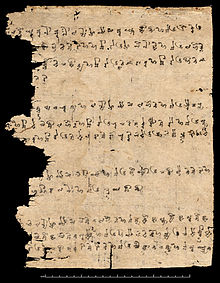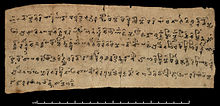| Saka | |
|---|---|
| Khotanese, Tumshuqese | |
| Native to | Kingdom of Khotan, Tumshuq, Murtuq, Shule Kingdom,[1] and Indo-Scythian Kingdom |
| Region | Tarim Basin (Xinjiang, China) |
| Ethnicity | Saka |
| Era | 100 BC – 1,000 AD |
| Dialects |
|
| Brahmi, Kharosthi | |
| Language codes | |
| ISO 639-2 | kho |
| ISO 639-3 | Either:kho – Khotanesextq – Tumshuqese |
kho (Khotanese) | |
xtq (Tumshuqese) | |
| Glottolog | saka1298 |
| Part of a series on |
| Indo-European topics |
|---|
 |



Saka, or Sakan, was a variety of Eastern Iranian languages, attested from the ancient Buddhist kingdoms of Khotan, Kashgar and Tumshuq in the Tarim Basin, in what is now southern Xinjiang, China. It is a Middle Iranian language.[2] The two kingdoms differed in dialect, their speech known as Khotanese and Tumshuqese.
The Saka rulers of the western regions of the Indian subcontinent, such as the Indo-Scythians and Western Satraps, are traditionally assumed to have spoken practically the same language.[3] This has however been questioned by more recent research.[4]
Documents on wood and paper were written in modified Brahmi script with the addition of extra characters over time and unusual conjuncts such as ys for z.[5] The documents date from the fourth to the eleventh century. Tumshuqese was more archaic than Khotanese,[6] but it is much less understood because it appears in fewer manuscripts compared to Khotanese. The Khotanese dialect is believed to share features with the modern Wakhi and Pashto.[7][8][9][10][11][12][13] Saka was known as "Hvatanai" (from which the name Khotan) in contemporary documents.[14] Many Prakrit terms were borrowed from Khotanese into the Tocharian languages.
- ^ Mallory, J. P. (2010). "Bronze Age Languages of the Tarim Basin" (PDF). Expedition. Vol. 52, no. 3. Penn Museum. pp. 44–53. Archived from the original (PDF) on 9 January 2021. Retrieved 16 March 2013.
- ^ "Saka Language". Encyclopædia Britannica. Archived from the original on 2014-04-07. Retrieved 2012-10-26.
- ^ Diringer, David (1953) [1948]. The Alphabet: A Key to the History of Mankind (Second and revised ed.). London: Hutchinson's Scientific and Technical Publications. p. 350.
- ^ Michaël Peyrot (2018). "Tocharian B etswe 'mule' and Eastern East Iranian". Farnah. Indo-Iranian and Indo-European Studies in Honor of Sasha Lubotsky. Ann Arbor, N.Y.: Beech Stave Press. Retrieved 14 November 2024.
In sum, the evidence that the Saka language [of North India] is Khotanese or an earlier form of it is weak. Many of the features are found in other languages as well, and it is known from other sources that non-Khotanese Iranians found their way to northern India. In any case, the large number of Indic elements in Khotanese is no proof "daß das 'Nordarisch' sprechende Volk längere Zeit auf indischem Boden saß" (Lüders 1913), since there is ample evidence that instead speakers of Middle Iranian migrated into the Tarim Basin.
- ^ Bailey, H. W. (1970). "Saka Studies: The Ancient Kingdom of Khotan". Iran. 8: 65–72. doi:10.2307/4299633. JSTOR 4299633.
- ^ History of Civilizations of Central Asia. Paris: UNESCO. 1992. p. 283. ISBN 92-3-103211-9.
- ^ Frye, R.N. (1984). The History of Ancient Iran. C.H.Beck. p. 192. ISBN 9783406093975.
[T]hese western Saka he distinguishes from eastern Saka who moved south through the Kashgar-Tashkurgan-Gilgit-Swat route to the plains of the sub-continent of India. This would account for the existence of the ancient Khotanese-Saka speakers, documents of whom have been found in western Sinkiang, and the modern Wakhi language of Wakhan in Afghanistan, another modern branch of descendants of Saka speakers parallel to the Ossetes in the west.
- ^ Bailey, H.W. (1982). The culture of the Sakas in ancient Iranian Khotan. Caravan Books. pp. 7–10.
It is noteworthy that the Wakhi language of Wakhan has features, phonetics, and vocabulary the nearest of Iranian dialects to Khotan Saka.
- ^ Carpelan, C.; Parpola, A.; Koskikallio, P. (2001). "Early Contacts Between Uralic and Indo-European: Linguistic and Archaeological Considerations: Papers Presented at an International Symposium Held at the Tvärminne Research Station of the University of Helsinki, 8–10 January, 1999". Suomalais-Ugrilainen Seura. 242: 136.
...descendants of these languages survive now only in the Ossete language of the Caucasus and the Wakhi language of the Pamirs, the latter related to the Saka once spoken in Khotan.
- ^ "Encolypedia Iranica, AFGHANISTAN vi. Paṣ̌tō".
It is, however, possible that the original home of Paṣ̌tō may have been in Badaḵšān, somewhere between Munǰī and Sangl. and Shugh., with some contact with a Saka dialect akin to Khotanese.
- ^ Indo-Iranica. Kolkata, India: Iran Society. 1946. pp. 173–174.
... and their language is most closely related to on the one hand with Saka on the other with Munji-Yidgha
- ^ Bečka, Jiří (1969). A Study in Pashto Stress. Academia. p. 32.
Pashto in its origin, is probably a Saka dialect.
- ^ Cheung, Jonny (2007). Etymological Dictionary of the Iranian Verb. (Leiden Indo-European Etymological Dictionary Series).
- ^ Bailey, H. W. (1939). "The Rāma Story in Khotanese". Journal of the American Oriental Society. 59 (4): 460–468. doi:10.2307/594480. JSTOR 594480.